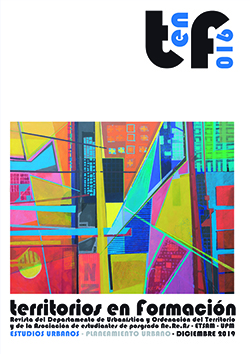El vínculo entre gentrificaión urbana y artistas: la autenticidad, diferenciación y disposición estética como protagonistas del proceso = The relation between gentrification and artists: authenticity, differentiation and aesthetic disposition as the process leaders
DOI:
https://doi.org/10.20868/tf.2019.16.4228Palabras clave:
Autenticidad, intención estética, disposición estética, diferenciación, distinción, capital cultura, authenticity, aesthetic intention, aesthetic disposition, differentiation, distinction, cultural capitalResumen
Resumen
La gentrificación de barrios en diversas ciudades del mundo se ve influenciado por la presencia de artistas como agentes de cambio. Ya sea en los casos de Nueva York, Rotterdam o Santiago de Chile, este grupo actúa como pionero al asentarse en barrios identificados con cualidades determinadas que los hace particularmente atractivos: entre ellas la autenticidad como una de las más importantes. Sin embargo, la disposición estética de los artistas que reconfigura el significado de los objetos por su aspecto formal y descontextualización, volviéndolos en objetos artísticos; también es capaz de hacerlo con los barrios en donde se implantan. De esta manera, el colectivo cambia poco a poco el carácter y significado de los barrios convirtiéndolos en objetos de referencia para todo aquel que busque un medio de diferenciación en la sociedad. Así, los barrios colonizados por artistas son mercantilizados por su valorización social y económica como consecuencia de su propia cultura y autenticidad, lo que conlleva a su gentrificación.
Abstract
The gentrification of neighborhoods around the globe cities has been strongly influenced by the presence of artists as agents. In cases such as New York, Rotterdam or Santiago de Chile, the group act as pioneers of the process by their settlement in specific neighborhoods with specific characteristics, being the authenticity one of the most important. Nevertheless, their aesthetic disposition that changes the meaning of objects by the emphasis in the formal aspect and decontextualization, becoming pieces of art; is also capable of changing the neighborhoods. This way, the group changes the character of the place they settle, becoming a reference object for anyone who seeks differentiation. As a result, neighborhoods colonized by artists, are commodificated by their social and economic value as a consequence of their own authenticity and culture that lead, finally, to a gentrification process.
Descargas
Referencias
Benjamin, W. (2003). La obra de arte en su época de reproductibilidad técnica. Ciudad de Mexico: Ítaca.
Bereitschaft, B., & Cammax, R. (2015). Neighborhood diversity and the creative class in Chicago. Applied Geography, 63, 166-183.
Bourdieu, P. (1993). The Field of Cultural Production. Nueva York: Columbia University Press.
Bourdieu, P. (2012). La Distinción. Santander: Taurus.
Cole, D. (1987). Artists and Urban Redevelopment. Geographical Review, 77 (4), 391-407.
Debord, G. (2002). La Sociedad del Espectáculo. Valencia: Pre-Textos.
De la Torre, C. (2017) ¿Regeneración urbana + Cultura = Gentrificación? Caso de estudio: El Raval (Barcelona) (Trabajo Fin de Master) Universidad Politécnica de Cataluña, Barcelona.
Döring, C., & Ulbritch, K. (2018). Gentrification Hotspots and Displacement in Berlin. A Quantitative Analysis. (I. Helbrecht, Ed.) Gentrification and Resistance, 9-35.
Florida, R. (2002). The rise of Creative Class and how its transforming work, leisure, community and every life. Nueva York: Basic Books.
Gombrich, E. (2003). Estilos artisticos y estilos de vida. En E. Gombrich, Los usos de las imagenes: estudio sobre la funcion social del arte y la comunicacion visual. Barcelona: Debate.
Harvey, D. (2009). The art of rent: Globalization, monopoly and the commodification of culture. Socialist Register, 38.
Heyuan, Y., & Chenmeng, B. (2017). Creative class agglomeration across time and space in knowledge city: Determinants and their relative importance. Habitat International, 60, 91- 100.
Ley, D. (2003). Artists, Aestheticisation and the Field of Gentrification. Urban Studies, 40 (12), 2527–2544.
Lorente, J. P. (2000). Art neighbourhoods, ports of Vitality. On the W@terfront (2), 48-73.
Lorente, J. P. (2009). ¿Qué es y cómo evoluciona un barrio artístico? Modernos internacionales en los procesos de regeneración urbana impulsados por las artes. En B. Fernández Quesada, & J. P. Lorente, Arte en el espacio público barrios artísticos y revitalización urbana (págs. 15-38). Universidad de Zaragoza.
Morales, V. (Noviembre de 2013). Academia.edu. Obtenido de https://www.academia.edu/10152818/La_contracultura_como_mercanc%C3%ADaç
Philip, L., Murphy, E., & Redmond, D. (2013). Residencial preferences of the Creative Class? Cities, 31, 47-56.
Roncayolo, M. (1988). La ciudad. Barcelona: Ediciones Paidos.
Rius, J. (2008). Los barrios artísticos como base local de la cultura global. El caso del Raval de Barcelona. Revista Internacional de Sociologia (RIS), LXVI (51).
Rossi, M.J. (2005) “Formalización y mercantilización de la obre de arte en Walter Benjamin” Cuadernos del Sur. Filosofía. Consultado el 03 de mayo, 2019. Disponible en <http://bibliotecadigital.uns.edu.ar/scielo.php?script=sci_arttext&pid=S1668- 74342005001100006&lng=es&nrm=iso>.
Schlack, E., & Turnbull, N. (2011). Capitalizando lugares auténticos: Artistas y emprendimientos en la regeneración urbana. ARQ (79), 28-42.
Siemer, J., & Matthews-Hunter, K. (2017). The spatial pattern of gentrification in Berlin. Praire Perspectives: Geographical Essays (19), 49-57.
Sorando, D., & Adura, A. (2016). First we take Manhattan: la destruccion creativa de las ciudades. Madrid: Libros La Catarata.
Van Ulzen, P. (2007). Imagine a Metropolis: Rotterdams Creative Class 1970-2000. Rotterdam: 010 Publishers.
Zukin, S. (2011). Reconstructing the authenticity of a place. Theory and Society , 40, 161- 165.
Zukin, S., & Braslow, L. (2011). The life cycle of New York’s creative districts: Reflections on the unanticipated consequences of unplanned cultural zones. City, Culture and Society , 2, 131–140.









